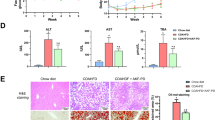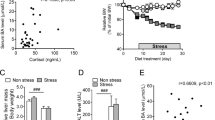Abstract
Alisol B 23-acetate (AB23A) is a natural triterpenoid isolated from the traditional Chinese medicine rhizoma alismatis, which exhibits a number of pharmacological activities, including anti-hepatitis virus, anti-cancer and antibacterial effects. In this study we examined whether AB23A protected against non-alcoholic steatohepatitis (NASH) in mice, and the mechanisms underlying the protective effects. NASH was induced in mice fed a methionine and choline-deficient (MCD) diet for 4 weeks. The mice were simultaneously treated with AB23A (15, 30, and 60 mg·kg−1·d−1, ig) for 4 weeks. On the last day, blood samples and livers were collected. Serum liver functional enzymes, inflammatoru markers were assessed. The livers were histologically examined using H&E, Oil Red O, Masson's trichrome and Sirius Red staining. Mouse primary hepatocytes were used for in vitro experiments. The mechanisms underlying AB23A protection were analyzed using siRNA, qRT-PCR, and Western blot assays. AB23A treatment significantly and dose-dependently decreased the elevated levels of serum ALT and AST in MCD diet-fed mice. Furthermore, AB23A treatment significantly reduced hepatic triglyceride accumulation, inflammatory cell infiltration and hepatic fibrosis in the mice. AB23A-induced decreases in serum and hepatic lipids were related to decreased hepatic lipogenesis through decreasing hepatic levels of SREBP-1c, FAS, ACC1 and SCD1 and increased lipid metabolism via inducing PPARα, CPT1α, ACADS and LPL. The reduction in inflammatory cell infiltration corresponded to deceased serum levels of mKC and MCP-1 and decreased hepatic gene expression of MCP-1 and VCAM-1. The reduction in hepatic fibrosis was correlated with decreased hepatic gene expression of fibrosis markers. The protective effects of AB23A were FXR-dependent, because treatment with the FXR agonist CDCA mimicked AB23A-induced hepato-protection in the mice, whereas co-administration of FXR antagonist guggulsterone abrogated AB23A-induced hepato-protection. In mouse primary hepatocytes, FXR gene silencing abrogated AB23A-induced changes in gene expression of Apo C-II, CPT1α, ACADS and LPL. AB23A produces protective effects against NASH in mice via FXR activation.
Similar content being viewed by others
Log in or create a free account to read this content
Gain free access to this article, as well as selected content from this journal and more on nature.com
or
References
Scorletti E, West AL, Bhatia L, Hoile SP, McCormick KG, Burdge GC, et al. Treating liver fat and serum triglyceride levels in NAFLD, effects of PNPLA3 and TM6SF2 genotypes: Results from the WELCOME trial. J Hepatol 2015; 63: 1476–83.
Nascimbeni F, Pais R, Bellentani S, Day CP, Ratziu V, Loria P, et al. From NAFLD in clinical practice to answers from guidelines. J Hepatol 2013; 59: 859–71.
McPherson S, Hardy T, Henderson E, Burt AD, Day CP, Anstee QM . Evidence of NAFLD progression from steatosis to fibrosing-steatohepatitis using paired biopsies: Implications for prognosis and clinical management. J Hepatol 2015; 62: 1148–55.
Gan L, Meng ZJ, Xiong RB, Guo JQ, Lu XC, Zheng ZW, et al. Green tea polyphenol epigallocatechin-3-gallate ameliorates insulin resistance in non-alcoholic fatty liver disease mice. Acta Pharmacol Sin 2015; 36: 597–605.
Ratziu V, Goodman Z, Sanyal A . Current efforts and trends in the treatment of NASH. J Hepatol 2015; 62: S65–S75.
Verdam FJ, Dallinga JW, Driessen A, Jonge Cd, Moonen EJC, van Berkel JBN, et al. Non-alcoholic steatohepatitis: A non-invasive diagnosis by analysis of exhaled breath. J Hepatol 2013; 58: 543–8.
Iyer S, Upadhyay PK, Majumdar SS, Nagarajan P . Animal models correlating immune cells for the development of NAFLD/NASH. J Clin Exp Hepatol 2015; 5: 239–45.
Forman BM, Goode E, Chen J, Oro AE, Bradley DJ, Perlmann T, et al. Identification of a nuclear receptor that is activated by farnesol metabolites. Cell 1995; 81: 687–93.
Zhu Y, Li F, Guo GL . Tissue-specific function of farnesoid X receptor in liver and intestine. Pharmacol Res 2011; 63: 259–65.
Cariou B . The farnesoid X receptor (FXR) as a new target in non-alcoholic steatohepatitis. Diabetes Metab 2008; 34: 685–91.
Jiao Y, Lu Y, Li XY . Farnesoid X receptor: a master regulator of hepatic triglyceride and glucose homeostasis. Acta Pharmacol Sin 2015; 36: 44–50.
Li G, Kong B, Zhu Y, Zhan L, Williams JA, Tawfik O, et al. Small heterodimer partner overexpression partially protects against liver tumor development in farnesoid X receptor knockout mice. Toxicol Appl Pharmacol 2013; 272: 299–305.
Watanabe M, Houten SM, Wang L, Moschetta A, Mangelsdorf DJ, Heyman RA, et al. Bile acids lower triglyceride levels via a pathway involving FXR, SHP, and SREBP-1c. J Clin Invest 2004; 113: 1408–18.
Kast HR, Nguyen CM, Sinal CJ, Jones SA, Laffitte BA, Reue K, et al. Farnesoid X-activated receptor induces apolipoprotein C-II transcription: a molecular mechanism linking plasma triglyceride levels to bile acids. Mol Endocrinol 2001; 15: 1720–8.
Claudel T, Inoue Y, Barbier O, Duran-Sandoval D, Kosykh V, Fruchart J, et al. Farnesoid X receptor agonists suppress hepatic apolipoprotein CIII expression. Gastroenterology 2003; 125: 544–55.
Pellicciari R, Fiorucci S, Camaioni E, Clerici C, Costantino G, Maloney PR, et al. 6alpha-ethyl-chenodeoxycholic acid (6-ECDCA), a potent and selective FXR agonist endowed with anticholestatic activity. J Med Chem 2002; 45: 3569–72.
Gadaleta RM, Cariello M, Sabba C, Moschetta A . Tissue-specific actions of FXR in metabolism and cancer. Biochim Biophys Acta 2015; 1851: 30–9.
Wang C, Zhang JX, Shen XL, Wan CK, Tse AK, Fong WF . Reversal of P-glycoprotein-mediated multidrug resistance by Alisol B 23-acetate. Biochem Pharmacol 2004; 68: 843–55.
Jin HG, Jin Q, Ryun Kim A, Choi H, Lee JH, Kim YS, et al. A new triterpenoid from Alisma orientale and their antibacterial effect. Arch Pharm Res 2012; 35: 1919–26.
Jiang ZY, Zhang XM, Zhang FX, Liu N, Zhao F, Zhou J, et al. A new triterpene and anti-hepatitis B virus active compounds from Alisma orientalis. Planta Med 2006; 72: 951–4.
Xu YH, Zhao LJ, Li Y . Alisol B acetate induces apoptosis of SGC7901 cells via mitochondrial and phosphatidylinositol 3-kinases/Akt signaling pathways. World J Gastroenterol 2009; 15: 2870–7.
Huang YT, Huang DM, Chueh SC, Teng CM, Guh JH . Alisol B acetate, a triterpene from Alismatis rhizoma, induces Bax nuclear translocation and apoptosis in human hormone-resistant prostate cancer PC-3 cells. Cancer Lett 2006; 231: 270–8.
Zhang LL, Xu YL, Tang ZH, Xu XH, Chen X, Li T, et al. Effects of alisol B 23-acetate on ovarian cancer cells: G1 phase cell cycle arrest, apoptosis, migration and invasion inhibition. Phytomedicine 2016; 23: 800–9.
Hur JM, Choi JW, Park JC . Effects of methanol extract of Alisma orientale rhizome and its major component, alisol B 23-acetate, on hepatic drug metabolizing enzymes in rats treated with bromobenzene. Arch Pharm Res 2007; 30: 1543–9.
Meng Q, Chen X, Wang C, Liu Q, Sun H, Sun P, et al. Alisol B 23-acetate promotes liver regeneration in mice after partial hepatectomy via activating farnesoid X receptor. Biochem Pharmacol 2014; 92: 289–98.
Klaunig JE, Goldblatt PJ, Hinton DE, Lipsky MM, Chacko J, Trump BF . Mouse liver cell culture. I. Hepatocyte isolation. In Vitro 1981; 17: 913–25.
Anstee QM, Goldin RD . Mouse models in non-alcoholic fatty liver disease and steatohepatitis research. Int J Exp Pathol 2006; 87: 1–16.
Filozof C, Goldstein BJ, Williams RN, Sanyal A . Non-alcoholic steatohepatitis: limited available treatment options but promising drugs in development and recent progress towards a regulatory approval pathway. Drugs 2015; 75: 1373–92.
Mudaliar S, Henry RR, Sanyal AJ, Morrow L, Marschall HU, Kipnes M, et al. Efficacy and safety of the farnesoid X receptor agonist obeticholic acid in patients with type 2 diabetes and nonalcoholic fatty liver disease. Gastroenterology 2013; 145: 574–582.e571.
Neuschwander-Tetri BA, Loomba R, Sanyal AJ, Lavine JE, Van Natta ML, Abdelmalek MF, et al. Farnesoid X nuclear receptor ligand obeticholic acid for non-cirrhotic, non-alcoholic steatohepatitis (FLINT): a multicentre, randomised, placebo-controlled trial. Lancet 2015; 385: 956–65.
Zhang S, Wang J, Liu Q, Harnish DC . Farnesoid X receptor agonist WAY-362450 attenuates liver inflammation and fibrosis in murine model of non-alcoholic steatohepatitis. J Hepatol 2009; 51: 380–8.
Acknowledgements
This present study was financially supported by a grant from the National Natural Science Foundation of China (No 81302826, 81473280) and the Program for Key Laboratory of Liaoning Province (No LZ2015027).
Author information
Authors and Affiliations
Corresponding authors
Rights and permissions
About this article
Cite this article
Meng, Q., Duan, Xp., Wang, Cy. et al. Alisol B 23-acetate protects against non-alcoholic steatohepatitis in mice via farnesoid X receptor activation. Acta Pharmacol Sin 38, 69–79 (2017). https://doi.org/10.1038/aps.2016.119
Received:
Accepted:
Published:
Issue date:
DOI: https://doi.org/10.1038/aps.2016.119
Keywords
This article is cited by
-
Attenuation of estrogen and its receptors in the post-menopausal stage exacerbates dyslipidemia and leads to cognitive impairment
Molecular Brain (2023)
-
The Alisma and Rhizoma decoction abates nonalcoholic steatohepatitis-associated liver injuries in mice by modulating oxidative stress and autophagy
BMC Complementary and Alternative Medicine (2019)



